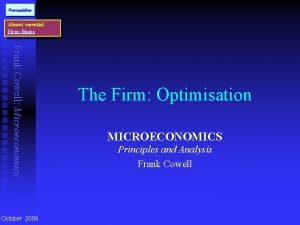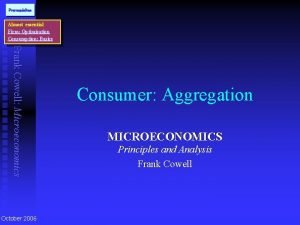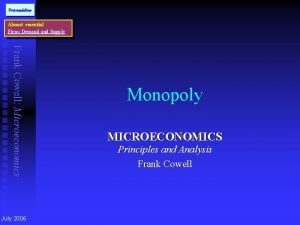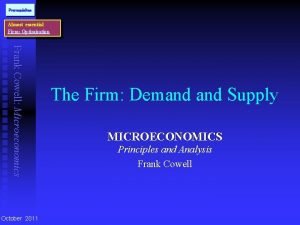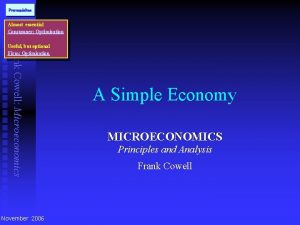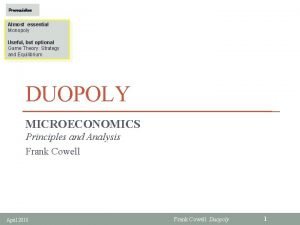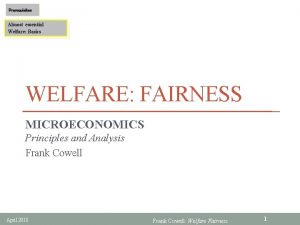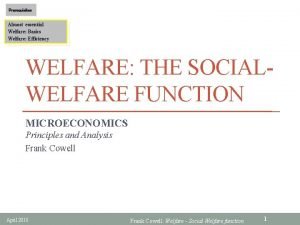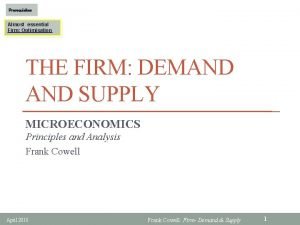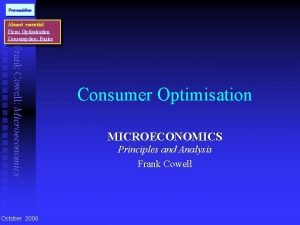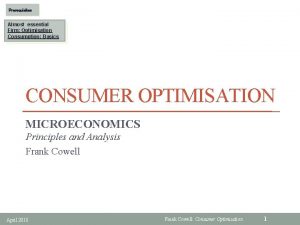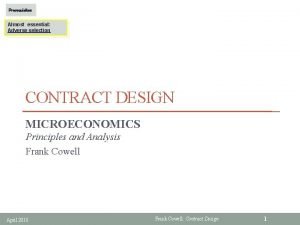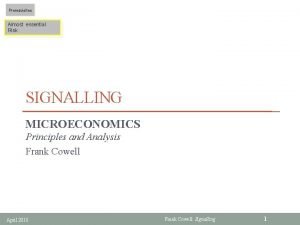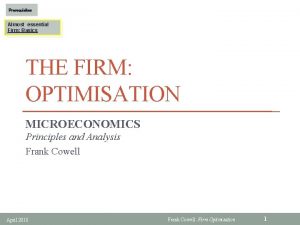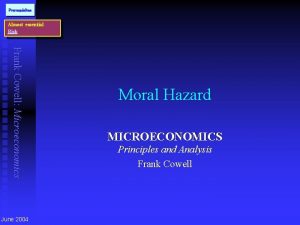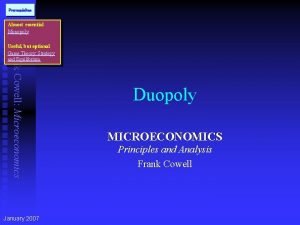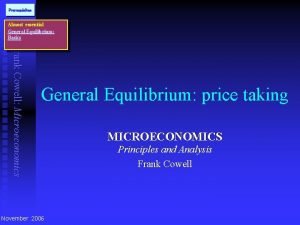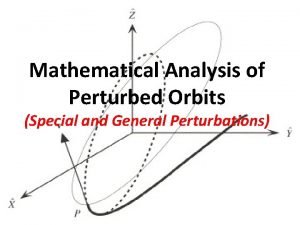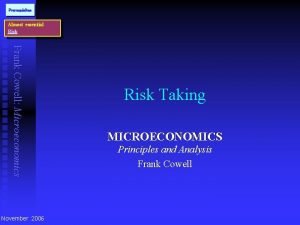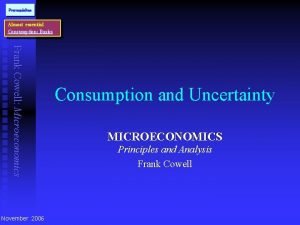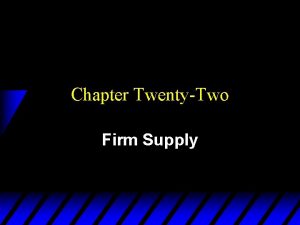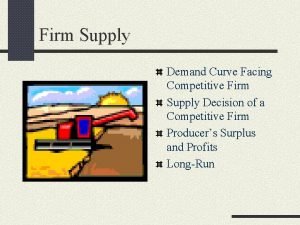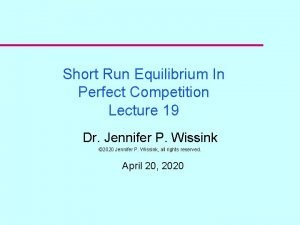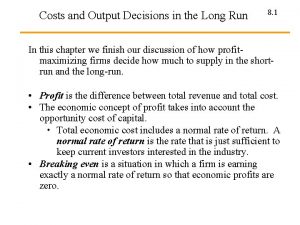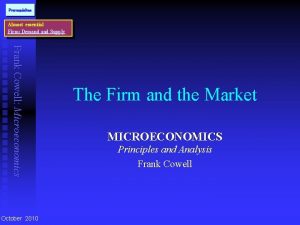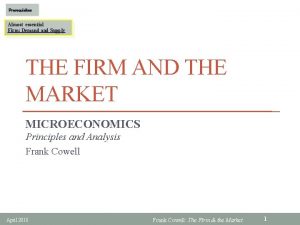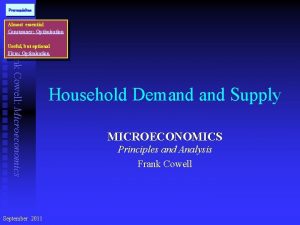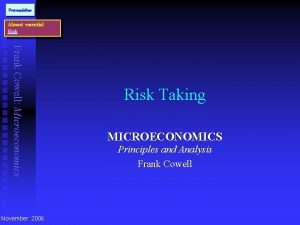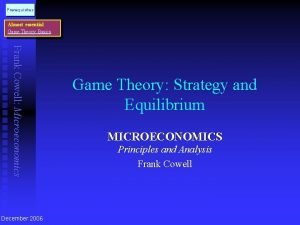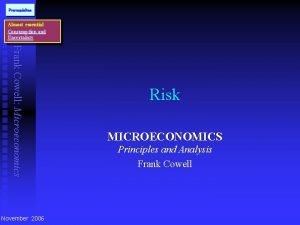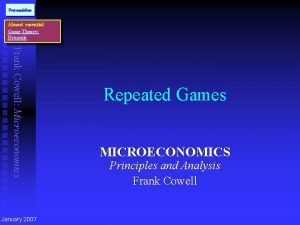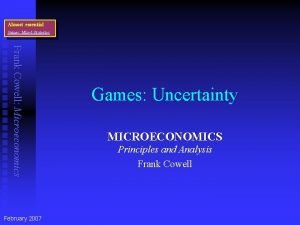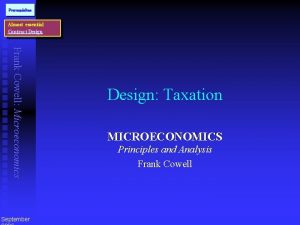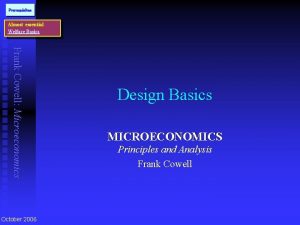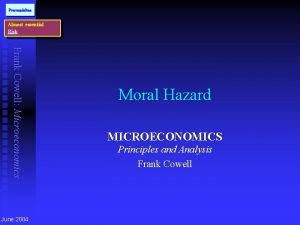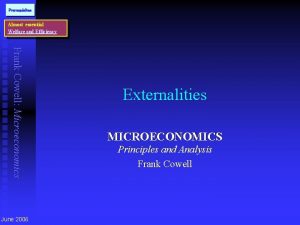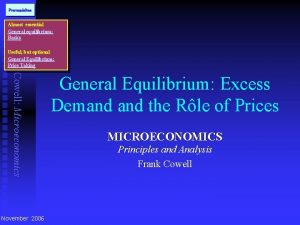Prerequisites Almost essential Firm Demand Supply Frank Cowell




































- Slides: 36

Prerequisites Almost essential Firm: Demand Supply Frank Cowell: Microeconomics July 2006 Monopoly MICROECONOMICS Principles and Analysis Frank Cowell

What is monopoly? Frank Cowell: Microeconomics n Consider a simple model of market power u u u n An artificial construct? u u n What prevents there being other firms in the industry? Or other firms that could potentially replace this firm? Or firms producing very close substitutes? Assume monopoly position is guaranteed by an exogenous factor (the law? ) Here we will examine: u u u n One seller, multiple buyers Buyers act as price-takers Seller determines price …monopoly with different types of market power … the relationship with competitive market equilibrium A useful baseline case for more interesting models of the market Begin with an elementary model…

Overview. . . Monopoly Frank Cowell: Microeconomics Simple model An elementary extension of profit maximisation Exploitation Discriminating monopolist Product diversity

A simple price-setting firm Frank Cowell: Microeconomics n n n Contrast with the price-taking firm: Output price is no longer exogenous We assume a determinate demand curve No other firm’s actions are relevant Profit maximisation is still the objective

Monopoly – model structure Frank Cowell: Microeconomics n We are given the inverse demand function: u u u n Total revenue is: u n p(q)q. Differentiate to get monopolist’s marginal revenue (MR): u u n p = p(q) Gives the (uniform) price that would rule if the monopolist chose to deliver q to the market. For obvious reasons, consider it as the average revenue curve (AR). p(q)+pq(q)q pq( ) means dp( )/dq Clearly, if pq(q) is negative (demand curve is downward sloping), then MR < AR.

Average and marginal revenue Frank Cowell: Microeconomics §AR curve is just the market demand curve. . . p §Total revenue: area in the rectangle underneath §Differentiate total revenue to get marginal revenue p(q)q dq p(q) AR MR q

Monopoly – optimisation problem Frank Cowell: Microeconomics n Introduce the firm’s cost function C(q). u n From C we derive marginal and average cost: u u n P(q) = p(q)q C(q) The shape of P is important: u u u n MC: Cq(q). AC: C(q) / q. Given C(q) and total revenue p(q)q profits are: u n Same basic properties as for the competitive firm. We assume it to be differentiable Whether it is concave depends on both C( ) and p( ). Of course P(0) = 0. Firm maximises P(q) subject to q ≥ 0.

Monopoly – solving the problem Frank Cowell: Microeconomics n Problem is “max P(q) s. t. q ≥ 0, where : u n First- and second-order conditions for interior maximum: u u n u p(q) + pq(q)q = Cq(q) “Marginal Revenue = Marginal Cost” This condition gives the solution. u u u n p(q) + pq(q)q Cq(q) = 0. Rearrange this: u n Pq (q) = 0. Pqq (q) < 0. Evaluating the FOC: u n P(q) = p(q)q C(q). From above get optimal output q*. Put q* in p( ) to get monopolist’s price: p* = p(q* ). Check this diagrammatically…

Monopolist’s optimum Frank Cowell: Microeconomics §AR and MR p §Marginal and average cost §Optimum where MC=MR § Monopolist’s optimum price. § Monopolist’s profit MC AC p* AR P MR q* q

Monopoly – pricing rule Frank Cowell: Microeconomics n Introduce the elasticity of demand h: u u u n First-order condition for an interior maximum u n p(q) + pq(q)q = Cq(q) …can be rewritten as u n h : = d(log q) / d(log p) = qpq(q) / p h<0 p(q) [1+1/h] = Cq(q) This gives the monopolist’s pricing rule: u Cq(q) p(q) = ——— 1 + 1/h

Monopoly – the role of demand Frank Cowell: Microeconomics n Suppose demand were changed to u u n Marginal revenue and demand elasticity are now: u u n n n MR(q) = bpq(q) q + [a + bp(q) ] h = [a/b+ bp(q) ] / pq(q) Rotate the demand curve around (p*, q* ). db>0 and da = p( q* ) db < 0. u Price at q* remains the same. 0 u Marginal revenue at q* increases d. MR(q*) > 0. * 0 u Abs value of elasticity at q decreases d|h| < 0. u But what happens to optimal output? Differentiate FOC in the neighbourhood of q*: d. MR(q*)db + Pqq dq* = 0 So dq* > 0 if db>0. u n a + bp(q) a and b are constants.

Monopoly – analysing the optimum Frank Cowell: Microeconomics n Take the basic pricing rule u n Use the definition of demand elasticity u u u n n Cq(q) p(q) = ——— 1 + 1/h p(q) ³ Cq(q) p(q) > Cq(q) if |h| < ∞. “price > marginal cost” Clearly as |h| decreases : u output decreases u gap between price and marginal cost increases. What happens if h ³ 1?

What is going on? Frank Cowell: Microeconomics n n n To understand why there may be no solution consider two examples A firm in a competitive market: h = u p(q) = p A monopoly with inelastic demand: h = ½ 2 u p(q) = aq Same quadratic cost structure for both: u C(q) = c 0 + c 1 q + c 2 q 2 Examine the behaviour of P(q)

Profit in the two examples Frank Cowell: Microeconomics §P in competitive example P §P in monopoly example §Optimum in competitive example §No optimum in monopoly example There’s a discontinuity here 1000 800 600 400 h = 200 0 -200 q n n 20 40 q* h = ½ 60 80 100

The result of simple market power Frank Cowell: Microeconomics n There's no supply curve: u u n Price is artificially high: u u n For competitive firm market price is sufficient to determine output. Here output depends on shape of market demand curve. Price is above marginal cost Price/MC gap is larger if demand is inelastic There may be no solution: u What if demand is very inelastic?

Overview. . . Monopoly Frank Cowell: Microeconomics Simple model increased power for the monopolist? Exploitation Discriminating monopolist Product diversity

Could the firm have more power? Frank Cowell: Microeconomics n Consider how the simple monopolist acts: u u u n Consumer still makes some gain from the deal u u u n Consider the total amount bought as separate units The last unit (at q) is worth exactly p to the consumer Perhaps would pay more than p for previous units (for x < q) What is total gain made by the consumer? u Jump to “Consumer Welfare” Chooses a level of output q Market determines the price that can be borne p = p(q) Monopolist sells all units of output at this price p u This is given by area under the demand curve and above price p Conventionally known as consumer’s surplus q ∫ 0 p(x) dx pq n Use this to modify the model of monopoly power…

The firm with more power Frank Cowell: Microeconomics n Suppose monopolist can charge for the right to purchase u u n Charges a fixed “entry fee” F for customers Only works if it is impossible to resell the good This changes the maximisation problem u Profits are now F + pq C (q) q where F = ∫ 0 p(x) dx pq u n which can be simplified to q ∫ 0 p(x) dx C (q) Maximising this with respect to q we get the FOC p(q) = C (q) n This yields the optimum output…

Monopolist with entry fee Frank Cowell: Microeconomics §Demand curve p §Marginal cost §Optimum output §Price § Entry fee § Monopolist’s profit MC consumer’s surplus p** AC §Profits include the rectangle and the area trapped between the demand curve and p** P q** q

Monopolist with entry fee Frank Cowell: Microeconomics n We have a nice result u u Familiar FOC Price = marginal cost n Same outcome as perfect competition? n No, because consumer gets no gain from the trade u Firm appropriates all the consumer surplus through entry fee

Overview. . . Monopoly Frank Cowell: Microeconomics Simple model Monopolist working in many markets Exploitation Discriminating monopolist Product diversity

Multiple markets Frank Cowell: Microeconomics n Monopolist sells same product in more than one market u u n Can the monopolist separate the markets? u u u n n An alternative model of increased power Perhaps can discriminate between the markets Charge different prices to customers in different markets In the limit can see this as similar to previous case… …if each “market” consists of just one customer Essentials emerge in two-market case For convenience use a simplified linear model: u u Begin by reviewing equilibrium in each market in isolation Then combine model…. …how is output determined…? …and allocated between the markets

Monopolist: market 1 (only) Frank Cowell: Microeconomics §AR and MR p §Marginal and average cost §Optimum where MC=MR § Monopolist’s optimum price. § Monopolist’s profit p* MC P AC MR q* AR q

Monopolist: market 2 (only) Frank Cowell: Microeconomics §AR and MR p §Marginal and average cost §Optimum where MC=MR § Monopolist’s optimum price. § Monopolist’s profit p* MC P AC MR q* AR q

Monopoly with separated markets Frank Cowell: Microeconomics n Problem is now “max P(q 1, q 2) s. t. q 1, q 2 ≥ 0, where : u n First-order conditions for interior maximum: u u u n Pi (q 1, q 2) = 0, i = 1, 2 p 1(q 1)q 1 +p 1 q (q 1) = Cq(q 1 + q 2) p 2(q 2)q 2 +p 2 q (q 2) = Cq(q 1 + q 2) Interpretation: u u u n P(q 1, q 2) = p 1(q 1)q 1 + p 2(q 2)q 2 C(q 1 + q 2). “Market 1 MR = MC overall” “Market 2 MR = MC overall” So output in each market adjusted to equate MR Implication u u Set price in each market according to what it will bear Price higher in low-elasticity market

Optimum with separated markets Frank Cowell: Microeconomics § Marginal cost p §MR 1 and MR 2 §“Horizontal sum” §Optimum total output § Allocation of output to markets MC MR 1 q 1* q 2* q 1*+ MR 2 q 2* q

Optimum with separated markets Frank Cowell: Microeconomics § Marginal cost p §MR 1 and MR 2 §“Horizontal sum” §Optimum total output § Allocation of output to markets § Price & profit in market 1 p* MC P MR 1 q 1* AR 1 q

Optimum with separated markets Frank Cowell: Microeconomics § Marginal cost p §MR 1 and MR 2 §“Horizontal sum” §Optimum total output § Allocation of output to markets § Price & profit in market 1 § Price & profit in market 2 MC p* P AR 2 MR 2 q 2* q

Multiple markets again Frank Cowell: Microeconomics n n We’ve assumed that the monopolist can separate the markets What happens if this power is removed? u u n Retain assumptions about the two markets But now require same price Use the standard monopoly model u u Trick is to construct combined AR… …and from that the combined MR

Two markets: no separation Frank Cowell: Microeconomics §AR 1 and AR 2 §“Horizontal sum” p §Marginal revenue §Marginal and average cost §Optimum where MC=MR § Price and profit p* MC P AC AR MR q* q .

Frank Cowell: Microeconomics Compare prices and profits n n n Markets 1+2 Separated markets 1, 2 Combined markets 1+2 Higher profits if you can separate… Market 1 Market 2

Overview. . . Monopoly Frank Cowell: Microeconomics Simple model Monopolistic competition Exploitation Discriminating monopolist Product diversity

Market power and product diversity Frank Cowell: Microeconomics n Nature of product is a major issue in classic monopoly u u n Now suppose potentially many firms making substitutes u u u n No close substitutes? Otherwise erode monopoly position Firms' products differ one from another Each firm is a local monopoly – downward-sloping demand curve New firms can enter with new products Diversity may depend on size of market Like corner shops dotted around the neighbourhood Use standard analysis u u u Start with a single firm – use monopoly paradigm Then consider entry of others, attracted by profit… …process similar to competitive industry

Monopolistic competition: 1 firm Frank Cowell: Microeconomics §For simplicity take linear demand curve (AR) §The derived MR curve MC AC §Marginal and average costs §Optimal output for single firm §Price and profits p P 1 MR q 1 AR output of firm 1

Monopolistic competition: entry Frank Cowell: Microeconomics §Equilibrium with one local monopoly AC MC §Other local monopolies set up nearby §More local monopolies nearby §In the limit p p p P 1 f P Zero Profits MR MR q. Nf q 1 AR AR ARAR output of firm output of 1, . . . , firm N f 1 §Number of local monopolies, N determined by zero-profit condition

What next? Frank Cowell: Microeconomics n n n All variants reviewed here have a common element… Firm does not have to condition its behaviour on what other firms do… Does not attempt to influence behaviour of other firms u n Not even of potential entrants Need to introduce strategic interdependence
 Cowell microeconomics
Cowell microeconomics Frank cowell
Frank cowell Frank cowell
Frank cowell Frank cowell
Frank cowell Frank cowell
Frank cowell Module 5 supply and demand introduction and demand
Module 5 supply and demand introduction and demand Matching supply with demand
Matching supply with demand How to find cournot equilibrium
How to find cournot equilibrium Almost essential
Almost essential Almost essential
Almost essential Almost essential
Almost essential Almost essential
Almost essential Almost essential
Almost essential Optimisation
Optimisation Roy's identity
Roy's identity Almost essential
Almost essential Almost essential
Almost essential Almost essential
Almost essential What happens at this point?
What happens at this point? Cowell microeconomics
Cowell microeconomics Almost essential
Almost essential Cowell microeconomics
Cowell microeconomics Almost essential
Almost essential Aintree loss criteria
Aintree loss criteria Encke's method
Encke's method Cowell china
Cowell china Cowell microeconomics
Cowell microeconomics Cowell microeconomics
Cowell microeconomics Cowell microeconomics
Cowell microeconomics Kevin cowell
Kevin cowell Plamatic acid
Plamatic acid What is firm demand
What is firm demand The demand curve facing a competitive firm
The demand curve facing a competitive firm Frank william abagnale jr
Frank william abagnale jr Short term equilibrium
Short term equilibrium Short run supply curve for a perfectly competitive firm
Short run supply curve for a perfectly competitive firm Short run supply curve for a perfectly competitive firm
Short run supply curve for a perfectly competitive firm
